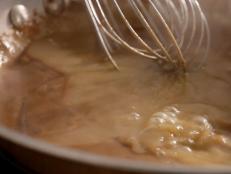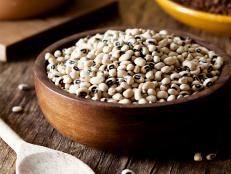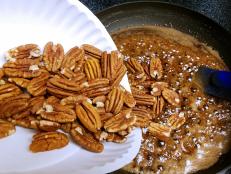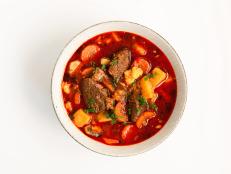What Are Chitlins?
These fried treats have a complex history in the South, and are reserved for special occasions like holiday tables.
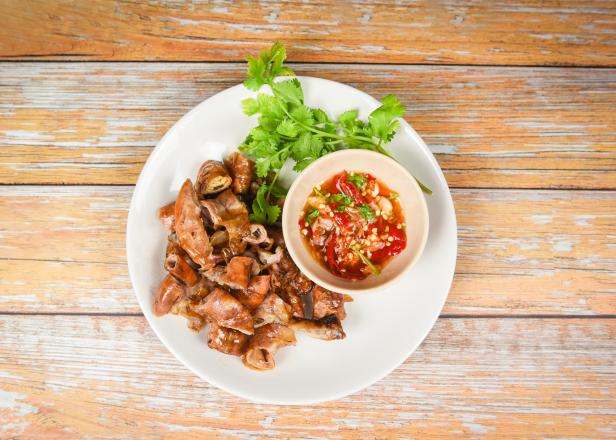
panida wijitpanya/Getty Images
By Layla Khoury-Hanold for Food Network Kitchen
Layla Khoury-Hanold is a contributor at Food Network.
You may have seen chitlins on menus, where they might make an appearance at soul food restaurants or whole hog barbecue joints. Or maybe you know them as a prize ingredient reserved for holiday tables and special occasions across the American South. Perhaps you know them as chitterlings, a delicacy that is enjoyed in parts of the Caribbean, Latin America or Western Europe. But what exactly are chitlins?
What Are Chitlins?
Chitlins, also called chitterlings, are the large intestines of swine (hogs) but can also come from calf or veal. Chitlins are typically either slow-cooked or fried, but because they are labor-intensive to clean and prepare, chitlins are often reserved for special occasions.
Chitlins History
In the U.S., chitterlings are associated with the American South and soul food. Consumption of chitterlings was partly born out of necessity; enslaved people often subsisted on the meat scraps leftover from hog killings. But cooking with offal such as hog intestines is also part of Western Africans’ whole animal cookery and preparing chitlins was a way for enslaved people to uphold those culinary traditions.
During the Jim Crow era, restaurants and music venues that served chitlins became synonymous with safe places for black performers; collectively, these places became known as the “Chitlin Circuit.” The town of Salley, South Carolina bills itself as the chitlin capital of the world; since the 1960’s, it has hosted the Chitlin’ Strut, an annual festival where chitterlings are celebrated and served.
Chitlins are also consumed around the world; in Caribbean and Latin American cuisine, chitterlings are used in a traditional stew called mondongo, and in French cuisine, they’re called les tricandilles and are grilled until crispy or used as casings for sausages.
What Do Chitlins Taste Like?
Chitlins have a mild flavor, so they readily take on the flavors of the seasonings they’re prepared or served with, such as aromatics and spices in the boiling liquid. Fried chitlins are often served with vinegar and hot sauce.
How to Prepare Chitlins
Once you’ve followed proper steps for cleaning, the chitlins can be boiled and simmered until tender, which can take several hours. You can add aromatics such as onions, garlic, bay leaves and vinegar to the boiling liquid.
Chitterlings can also be boiled and simmered until tender, then cut into 1-inch pieces, dipped in egg and dredged in breadcrumbs (or panko or crushed crackers), then deep-fried.
How to Clean Chitlins
Following safe food handling practices is extremely important when cleaning and preparing chitlins to prevent foodborne illness. This is because chitterlings can be contaminated with the bacteria Yersinia enterocolitica, which can cause people (especially young children) to be sick with yersiniosis .
According to USDA guidelines (U.S. Department of Agriculture), raw chitlins should be boiled for five minutes before cleaning to kill most of the bacteria.
Run the chitterlings under cold water and rinse away and discard any foreign matter. Transfer the cleaned chitlins to a pot of cold water to soak. Repeat this process until the water is clear.
Boil and simmer chitlins until well-done before serving or frying them; the boiling phase can take several hours.
If you’re unsure about cleaning, preparing and cooking chitlins, you can also purchase cleaned and pre-cooked chitlins.
Here are some tips for handling chitlins’, as informed by USDA guidance:
- Thaw frozen chitterlings in the refrigerator, never at room temperature. Wrap the container with the raw chitterlings in plastic wrap before placing it in the refrigerator to thaw. (This will eliminate drips that could cross-contaminate your refrigerator and other items in it.)
- Wash hands thoroughly with soap and warm water for 20 seconds before and after preparing chitterlings.
- Wash utensils, cutting boards, dishes and countertops with hot soapy water after preparing each food item, and before you move on to the next one.
- Sanitize countertops, equipment, utensils and cutting boards. Prepare a solution of 1 tablespoon of unscented, liquid chlorine bleach in 1 gallon of water. Flood the surface with the bleach solution and allow it to stand for several minutes. Rinse with clear water and air dry or pat dry with clean paper towels.
- While preparing chitterlings, caregivers should enlist the help of others to care for infants and small children to prevent cross-contamination and infections.
- Keep children out of the kitchen when chitterlings are being prepared.
- Boil and simmer chitterlings until well cooked and tender.
Storage tips:
- Refrigerate and use raw chitterlings within 2 days after thawing.
- Use frozen chitterlings within 3 to 4 months for best quality.
- Cooked chitterlings can stay for 3 to 4 days in the refrigerator or 3 to 4 months in the freezer.
Related Links:

























